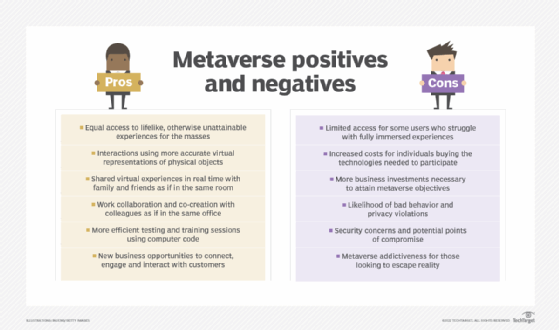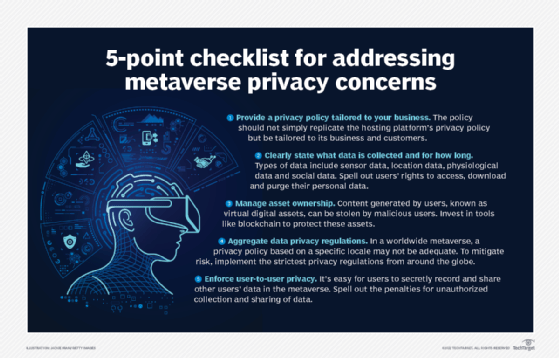The metaverse may be on the horizon, but precursor and metaverse-like experiences are already a reality. Yet most people aren’t sold on the concept of the metaverse.
An early 2022 poll taken by news site Axios and AI platform maker Momentive found that most respondents were ambivalent about the metaverse, with 60% indicating they were unfamiliar with the idea of the metaverse. Although far more respondents were “scared” than “excited” about the metaverse, 58% said they were neither scared nor excited about the coming immersive digital world.
As envisioned by analysts and researchers, the metaverse will be a persistent, immersive shared digital environment where people can interact with each other and transact with businesses. It will blend the physical and virtual worlds, allowing people to engage in an online 3D space, or the spatial web, almost as if their experience were real life. Other technologies, including artificial intelligence, blockchain, and virtual reality (VR) and augmented reality headsets, will enable key metaverse functions and experiences.
Although the metaverse doesn’t yet exist in its truest sense, it is coming. Technology companies are making investments in it, and many enterprises are building and testing their own versions of it.
In its early “2022 Pulse Survey,” professional services firm PwC revealed that 46% of respondents, including CIOs and CTOs, “consider the metaverse to be very important to their innovation strategy.” And research firms, consultancies and industry observers have pegged the metaverse market in part or whole at anywhere from hundreds of billions to multiple trillions of dollars by 2030.
That massive economic potential is just one of many expected benefits. But, along with the upsides come downsides. Here’s look at the anticipated pros and cons of the metaverse, according to analysts, consultants, executives and researchers.

Metaverse pros
A fully realized metaverse may still be a decade or more away, but several positives and emerging applications that technology delivers have already been identified.
Improbable and even impossible experiences
Only a select few can venture into outer space, have the fortitude to scale the Himalayas or are athletic enough to surf the largest waves. The metaverse, however, is expected to deliver lifelike experiences such as these to the masses in their own environments. “One of the advantages of the immersive experience is it allows you to have experiences you otherwise wouldn’t have,” explained Daniel Mintz, chair of the IT department at the University of Maryland Global Campus, which has piloted immersive learning experiences using VR headsets.
More equal access to virtual experiences
The metaverse could be an equalizer, giving people access to existing experiences that were shut off to them for reasons such as cost, distance or disabilities. “A lot of things are possible today, like a ride over the Grand Canyon, but not everyone has the time and money to do that,” said Sachin Mittal, executive director at Singapore-based DBS Bank. With the metaverse, he added, “you’re able to live the life you want to live.”
Heightened social connections and lifelike interactions
Users can expect not only to have new experiences in the metaverse, they’ll also be able to share those experiences in real time with friends, family or anyone they want, as if they’re together in the real world. The metaverse will enable “a richer social experience” than today’s internet and even modern gaming platforms, conjectured J. P. Gownder, vice president and principal analyst at Forrester Research. In addition, the metaverse will mimic elements of real-world social interactions in ways that the current 2D internet can’t, he said. Today’s video conferencing with boxes of talking heads will look, and more importantly, provide the feeling that everyone’s together in the same location. Avatars would gather as a group or break off into smaller gatherings, just as people do in face-to-face social situations.
More accurate representations of physical objects in the virtual world
The metaverse will let people more accurately see and interact with physical objects as if they were real, Gownder said. A car shopper, for example, could visit an auto dealer in a fully immersive spatial web, examine car models and test drive them as if in the real world.
Better collaboration and co-creation
Because the metaverse promises to mimic real-world social interactions and accurately represent physical objects in three dimensions, individuals will be able to collaborate as if they were all in the same room. In fact, using VR headsets, surgeons in Brazil successfully separated conjoined twins with real-time assistance from surgeons located in their own countries. Moreover, people will be able to come together in the metaverse and co-create in new ways, noted Thomas Olsen, partner and global co-lead of the Web3 and metaverse practice at management consulting firm Bain & Company.
More effective, efficient testing and training
The metaverse will do more than support remote work and collaboration beyond geographic and physical barriers; it will enable a whole new level of testing and training with great efficiency. Teams will be able to test ideas as well as train and practice in the metaverse with computer code instead of physical resources. The surgeons who separated conjoined twins first practiced the procedure using virtual reality. Many organizations see this type of application as an entry into the metaverse, said Emmanuelle Rivet, vice chair of U.S. TMT and global technology leader at PwC, citing PwC’s “2022 U.S. Metaverse Survey,” whose respondents ranked onboarding and training highest among business use cases, followed by interacting with work colleagues.
New business opportunities
The metaverse’s unlimited potential reaches beyond technology companies and gaming platforms. Businesses are beginning to use the metaverse-like experiences to connect, engage and interact with customers in new and different ways. Fidelity Investments, for example, created an immersive experience in Decentraland to educate and engage consumers in the digital world, while luxury fashion brands are already selling virtual versions of their wares in digital department stores.

Metaverse cons
On the road to the metaverse, businesses and individuals need to be aware of potential potholes along way.
Limited participation for some
Simulator sickness is a form of motion sickness that users can suffer during immersive experiences. Technological advances address the latency issues that cause motion sickness, Rivet noted, but she acknowledged that some users may have trouble with fully immersed experiences in virtual spaces. Individuals with auditory or visual disabilities may also have difficulties in the metaverse.
Higher equipment costs
Individuals and enterprises alike will have to shell out some cash to get into the metaverse. Individuals will have to buy the technology that’s needed to participate, such as VR headsets. Companies are looking at greater costs as they determine what they’ll do with the metaverse, when they should start making investments and what capabilities they’ll have to purchase to reach their objectives, Gownder said.
Potential for bullying, harassments and assaults
Bad behavior in the real world, on the internet and across social media has likewise occurred in existing metaverse-like experiences. Some women, for example, reported that their avatars were groped. Organizations will have to think about the potential for such problems and what safeguards and policies they’ll need to establish to address those issues, Olsen said. For instance, Meta, the parent company of Facebook and creator of the virtual world online game Horizon Worlds, added a default bubble called Personal Boundary to its avatars “that will give people more control over their VR experience.”
Additional privacy concerns and security issues
Questions remain about how organizations will approach privacy in the metaverse. Will companies, for example, require avatars to reveal their real identity under all circumstances or just some? Will they hold and use the extensive amount of data they collect on individual users in the metaverse, or instead will government regulators or users themselves seek to limit the use of data? And how will businesses secure the metaverse, since additional devices like VR headsets will create more potential points of compromise?
More reasons for addictive behavior
The metaverse, more so than video games, can potentially be addictive to some people who are looking for an escape. They may lose “the ability to distinguish reality and virtual reality,” Mintz warned.
This is just the beginning
The metaverse is “a gradual story that will evolve over years,” Olsen noted, with multiple factors influencing how quickly the metaverse will mature, including the pace of consumer adoption, the rate of enterprise investment and government regulations. “It’s a path we’ll have to navigate through,” Olsen said, adding that the metaverse’s potential pros and cons will vary from organization to organization based on how they plan to use the technology.
The metaverse “is a very immature environment, it’s still evolving,” Rivet concurred. Companies should experiment, she added, but at the same time be “risk aware.”
Read More: news.google.com









 Bitcoin
Bitcoin  Ethereum
Ethereum  XRP
XRP  Tether
Tether  Solana
Solana  Dogecoin
Dogecoin  USDC
USDC  Cardano
Cardano  Lido Staked Ether
Lido Staked Ether  TRON
TRON  Avalanche
Avalanche  Sui
Sui  Wrapped stETH
Wrapped stETH  Chainlink
Chainlink  Toncoin
Toncoin  Shiba Inu
Shiba Inu  Stellar
Stellar  Wrapped Bitcoin
Wrapped Bitcoin  Hedera
Hedera  Polkadot
Polkadot  WETH
WETH  Bitcoin Cash
Bitcoin Cash  Uniswap
Uniswap  Pepe
Pepe  Hyperliquid
Hyperliquid  Litecoin
Litecoin  LEO Token
LEO Token  Wrapped eETH
Wrapped eETH  NEAR Protocol
NEAR Protocol  Internet Computer
Internet Computer  Ethena USDe
Ethena USDe  USDS
USDS  Aptos
Aptos  Aave
Aave  Render
Render  Mantle
Mantle  Cronos
Cronos  POL (ex-MATIC)
POL (ex-MATIC)  Bittensor
Bittensor  Ethereum Classic
Ethereum Classic  Artificial Superintelligence Alliance
Artificial Superintelligence Alliance  WhiteBIT Coin
WhiteBIT Coin  Virtuals Protocol
Virtuals Protocol  Arbitrum
Arbitrum  MANTRA
MANTRA  Filecoin
Filecoin  Tokenize Xchange
Tokenize Xchange